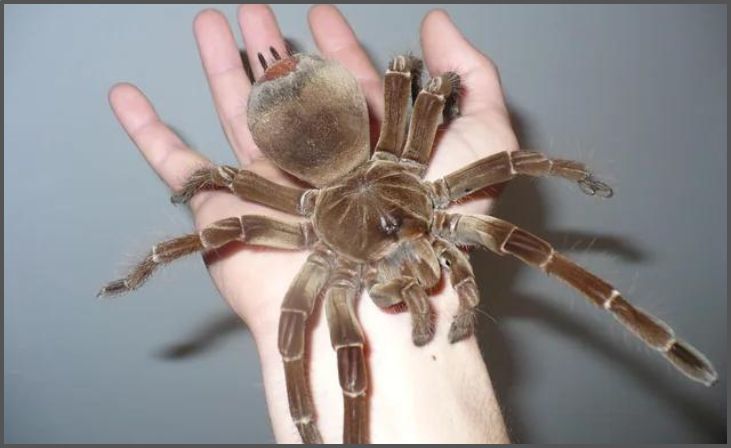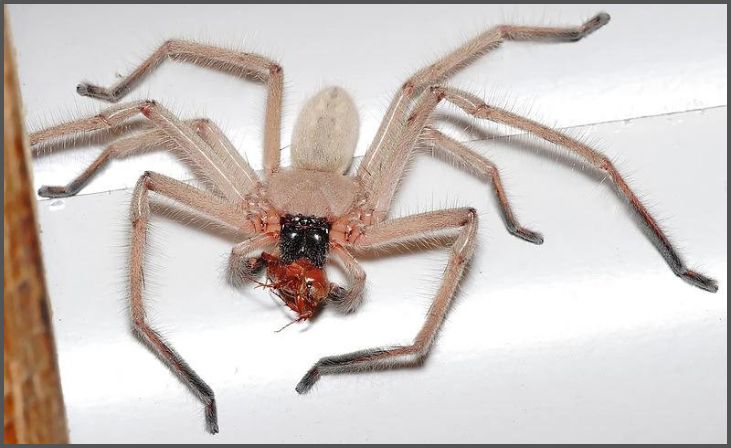In the realm of arachnids, size can be both fascinating and terrifying. While many people shudder at the mere thought of encountering a spider, there’s an undeniable intrigue when it comes to the largest species that still roam the Earth. As we delve into the vast and diverse world of spiders, let’s uncover the nine biggest spiders that continue to make their presence known in 2024.
Goliath Birdeater (Theraphosa blondi):

Kicking off our list is the infamous Goliath birdeater, a colossal spider known for its intimidating size and impressive leg span. Found primarily in the rainforests of South America, this tarantula species is not only the largest spider by mass but also boasts fangs capable of delivering a painful bite. Despite its name, its diet mostly consists of insects, though it won’t shy away from small vertebrates if given the opportunity.
Brazilian Wandering Spider (Phoneutria spp.):
Don’t let its name fool you; the Brazilian wandering spider isn’t just a wanderer—it’s a formidable predator. This arachnid, native to South and Central America, holds the title for the world’s most venomous spider. While its venom can be lethal to its prey, including insects, small rodents, and even other spiders, its bite can also pose a significant threat to humans if left untreated.
Huntsman Spider (Sparassidae):

With their distinctive flattened bodies and leg spans reaching up to a foot across, huntsman spiders are a sight to behold. These agile predators are found in various regions worldwide, including Australia, Asia, Africa, and the Americas. Despite their formidable appearance, huntsman spiders are generally harmless to humans and play a crucial role in controlling insect populations.
Giant Huntsman Spider (Heteropoda maxima):
As if regular huntsman spiders weren’t impressive enough, along comes the giant huntsman spider to up the ante. Hailing from the caves of Laos, this arachnid holds the record for the world’s largest by leg span. While its size might instill fear in some, the giant huntsman spider is relatively harmless to humans, preferring to feast on insects and other invertebrates.
Colombian Giant Red-Legged Tarantula (Megaphobema robustum):

Native to the rainforests of Colombia, the Colombian giant red-legged tarantula lives up to its name with its robust build and striking coloration. While its venom is potent enough to subdue its prey, including insects and small vertebrates, it poses minimal danger to humans. Despite its imposing appearance, this tarantula species is a popular choice among exotic pet enthusiasts.
Giant Tailless Whip Scorpion (Phrynus spp.):
While not technically a spider, the giant tailless whip scorpion earns its spot on our list due to its impressive size and appearance. Found in tropical regions worldwide, these arachnids possess formidable front pedipalps resembling claws and lack the long tail seen in their close relatives, the whip scorpions. Despite their intimidating appearance, they are harmless to humans and primarily feed on insects.
Brazilian Salmon Pink Bird-Eating Tarantula (Lasiodora parahybana):
Another giant among tarantulas, the Brazilian salmon pink bird-eating tarantula, earns its name from its striking coloration and formidable size. Found in the forests of Brazil, this species boasts a leg span of up to 10 inches, making it one of the largest tarantulas in the world. Despite its intimidating appearance, this tarantula species is relatively docile and is a popular choice among tarantula enthusiasts.
Golden Silk Orb-Weaver (Nephila spp.):
Known for their impressive webs and striking golden silk, golden silk orb-weavers are some of the largest spiders in the world. Found in tropical and subtropical regions worldwide, these arachnids weave intricate webs that can span several feet in diameter. Despite their intimidating size, golden silk orb-weavers are harmless to humans and primarily feed on insects that become ensnared in their webs.
Australian Tarantulas (Selenocosmiinae):
Closing out our list are the various species of tarantulas found across Australia, collectively known as Australian tarantulas. From the massive Goliath birdeater to the colorful Australian tarantula, these spiders come in a range of shapes, sizes, and colors. Despite their imposing appearance, Australian tarantulas are generally docile and pose minimal threat to humans, preferring to feast on insects and other invertebrates.
Conclusion:
From the gargantuan Goliath birdeater to the intricate golden silk orb-weaver, the world of spiders is home to some truly impressive creatures. While their size and appearance may evoke fear in some, these arachnids play a vital role in maintaining ecosystems worldwide. As we continue to explore and study these fascinating creatures, let’s remember to appreciate the beauty and complexity of the natural world.


